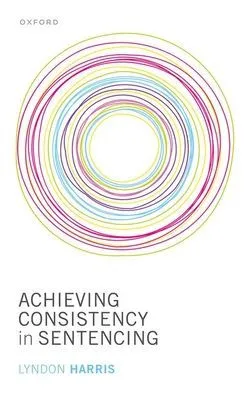Achieving Consistency in Sentencing
 Author: Lyndon Harris
Author: Lyndon Harris
Publisher: Oxford University Press, 2022. 352 pages.
Reviewer: Rob Canton | June 2023
Consistency in sentencing is widely held to be a fundamental component of criminal justice. Public and political debates periodically complain about inconsistencies–pointing to variations in levels of sentencing in different parts of the country and even among judges at specific courts. And it must be right to insist that. In all the disputes about the purposes and justifications of sentencing, decisions should depend on some feature of the offense or the offender and not the preferences, habits, or idiosyncrasies of those who sentence them.
Lyndon Harris has written a carefully argued and instructive study about how consistency might be achieved. Harris begins by explaining his decision to focus on England and Wales, suggesting that attention to the development of systems in this jurisdiction would be valuable to other countries. While conventional objections to inconsistency rest on comparisons–like cases should be treated alike–Harris is more concerned that sentences should be consistent with a principle. Unless sentencing is principled in this way, consistency could be thought of less as a matter of justice than a bureaucratic virtue, if any kind of virtue at all. After all, like cases could be treated alike, but all in an unprincipled manner. This approach to the question is persuasive, although somewhat at odds with the conception of consistency in political (and much academic) debate, which rests precisely on comparisons. Unprincipled sentencing is more likely to be impugned as unethical or unjust than as inconsistent.
Harris holds that punishment in proportion to the seriousness of the crime and the offender’s culpability is the paramount principle in England and Wales. ‘Limiting retributivism’ is the foundation of sentencing practice (although concerns about risk and preventive sanctions have sometimes threatened retributive limits). Legislation specifies purposes of sentencing (most of them intended to reduce crime by one means or another) to which courts must regard, and these may legitimately influence the sentencing decision–so long as the retributive parameters are respected. Yet these purposes are not ranked in order of importance, and it is a familiar criticism that this allows for questionable discrepancies. For example, if Judge A decides that deterrence must take priority (and awards a sentence of 6 months in prison), while Judge B dealing with a relevantly similar matter, favors rehabilitation (and decides on probation or community supervision), it would strain the meaning of the word to describe their approaches as consistent. Yet both would be respecting a principle, and therefore (so long as the sentence falls within the retributive parameters) would be right or, at worst, not wrong. For all the clear differences between them, both would meet Harris’s requirement for consistency.
In a particularly insightful Chapter 4, Harris explores the relationship between consistency and individualized justice–two presumptively desirable features of sentencing which are commonly taken to be incompatible. He argues persuasively that these are not only compatible, but that individualized justice is a precondition of consistency. Sound decisions must attend to the circumstances of the specific case. Justice is at risk not only when improper or irrelevant considerations influence a judgment, but also when relevant ones are overlooked. Here as elsewhere, Harris is concerned with consistency-with-principle, although his analysis would also apply to like-alike consistency.
Yet allowing sentencers to take proper account of the indefinitely many ways in which cases may differ one from another brings risks of its own. These reflections lead Harris to another searching and instructive Chapter 5 on discretion. He works his way towards a useful definition of discretion (distinguishing it, for example, from judgment) and engages with complex jurisprudential debates–which, for all their intrinsic importance, are perhaps covered in rather more detail than is necessary for the author’s argument here. The way to square the circle of enhancing consistency without trespassing on judicial autonomy and its ability to take account of all proper considerations is by structuring discretion. This might be achieved either by limiting discretion or giving guidance for its deployment. Some jurisdictions seek to limit discretion by binding courts in particular ways. Harris is especially opposed to rigidity (“inflexible rules tend to produce inconsistency” (p. 242)), to statutory minimum sentences, and to sentencing tables or grids, which strip away so many relevant factors and reduce individuals to their offenses and offending history. Endeavors to impose a strict uniformity on sentencing often end up with uniformly strict sentences. As Nils Christie remarked about sentencing grids: “In this situation, Lady Justice does not need to be blindfolded. She has nothing to look at, except a Table … But her sword is easier to use than ever. A sword directed by a Table.” Harris favors narrative guidelines which articulate approaches, principles, and the underlying rationales but allow judges the latitude to make wise and case-sensitive decisions.
Kenneth Culp Davis observed that discretion is inescapable in human decision-making (a good thing too!), although it can be moved around. For instance, sentencing tables set down in law move discretion from the judge to the legislature. Harris suggests that the system in England and Wales rests on a coherent and complementary division of labor among Parliament, the Court of Appeal, and the Sentencing Council, whose respective contributions are considered in Chapters 6, 7, and 8. Each of these chapters begins with a fascinating summary of the background and history that has shaped current arrangements. Although he is prepared to acknowledge shortcomings and propose improvements, Harris is broadly confident in the system of England and Wales and commends it to other jurisdictions. That said, while the distribution of responsibilities between the legislature and the judiciary may appear reasonably established, the increased politicization of questions of crime and punishment has made the boundaries more contested. Harris touches upon this (p. 148), but might profitably have said rather more about it. The more politicized sentencing policy becomes, the greater the temptation for the legislature to try to annex judicial territory.
This has implications for the potential for other countries to model their arrangements on the experiences and practices of England and Wales. Indeed, policy transfer and the learning of lessons are always mediated by a large, if uncertain, number of social, legal, political, economic, and professional variables–interacting in unpredictable ways. England’s own history attests to some of the tussles of which the present arrangements are the product, and there can be no guarantee at all that attempts at emulation by other countries would produce the same results.
While legal scholars are properly concerned with consistency in sentencing, for many people, this is just one aspect of the broader challenge of securing justice in punishment. A focus on the court risks losing sight of the many decisions taken at an earlier stage. While these are beyond the control of the court–and beyond the scope of this book–the court cannot altogether insulate itself from these matters. To disregard the economic and social origins of offending and the (too often discriminatory) processes that may or may not lead to prosecution and sentencing is to risk collusion with injustice. Nor should it be forgotten that subsequent processes and experiences as the sentence is carried out may altogether subvert the principled decisions in court and fatally distort consistency in sentencing.
The impact of the same sentence can be very different. Michael Tonry puts this well: “A year in prison for a 19-year-old street gang member may be a rite of passage, a status enhancer, and a prerequisite to gang leadership. To a professional burglar, it may be a cost of doing business. To a diffident young man it may be terrorizing. To a 40-year-old head of household, it may break up a family and fundamentally alter its future. To a terminally ill 70-year-old, it may be a life sentence.” Indeed, it is doubtful that there could be any such thing as a ‘standard case:’ it is the diversity that is standard. Exploring this would require another and very different book, but there might, perhaps, have been some more explicit recognition of this wider context.
Lyndon Harris has written a detailed and meticulous account of consistency in sentencing in England and Wales. The author is a practicing barrister, as is shown in his forensic argumentation. The book has its origins in a doctoral thesis, and Harris’s vigilance in anticipating and addressing objections sometimes makes for a rather dense read. At the same time, his thoroughness and acumen make the effort eminently worthwhile.
Rob Canton is an Emeritus Professor in Community and Criminal Justice at De Montfort University in Leicester, UK.


